servants
 There is a tradition in England and a few other nations like Canada and Ireland, that takes place the day after Christmas, called Boxing Day. It is an odd name for a holiday, but I think the purpose of the holiday far outweighs the name of the holiday. People might argue the original purpose of the holiday, but the most straightforward answer as to what it is about would be that, “We are a little greedy here in the England and Ireland in wanting a more extended holiday. It is not enough for us to have only Christmas Day celebrations, we have added to this another event called Boxing Day.” That might be one part of the picture, but the full answer is not that simple. But firstly, it has nothing to do with the sport of boxing.
There is a tradition in England and a few other nations like Canada and Ireland, that takes place the day after Christmas, called Boxing Day. It is an odd name for a holiday, but I think the purpose of the holiday far outweighs the name of the holiday. People might argue the original purpose of the holiday, but the most straightforward answer as to what it is about would be that, “We are a little greedy here in the England and Ireland in wanting a more extended holiday. It is not enough for us to have only Christmas Day celebrations, we have added to this another event called Boxing Day.” That might be one part of the picture, but the full answer is not that simple. But firstly, it has nothing to do with the sport of boxing.
Boxing Day is a national Bank Holiday. It is a day to spend with family and friends and to eat up all the leftovers of Christmas Day, but there is more to it than that. The origins of the day are filled with history and tradition. People have long disputed the origins of the name Boxing Day. The name is actually a reference to holiday gifts. A “Christmas Box” in Britain is a name for a Christmas present. Boxing Day was traditionally a day off for the servants and the day when they received a “Christmas Box” from the master. The servants would also go home on Boxing Day to give “Christmas Boxes” to their families.
Traditionally, a box to collect money for the poor was placed in churches on Christmas day. The boxes were  opened the next day…Boxing Day. The name refers to a nautical tradition. Great sailing ships when setting sail would have a sealed box containing money on board for good luck. Were the voyage a success, the box was given to a priest, opened at Christmas and the contents then given to the poor. Boxing Day is the 26th December is a national holiday in England and Ireland.
opened the next day…Boxing Day. The name refers to a nautical tradition. Great sailing ships when setting sail would have a sealed box containing money on board for good luck. Were the voyage a success, the box was given to a priest, opened at Christmas and the contents then given to the poor. Boxing Day is the 26th December is a national holiday in England and Ireland.
Boxing Day is a time to spend with family or friends, but usually not those seen on Christmas Day itself. In recent times, the day has begun to include many sports. Horse racing is particularly popular with meets all over the country. Many top football teams also play on Boxing Day. Boxing Day is a time when the British show their eccentric side by taking part in all kinds of silly activities. Bizarre traditions include swimming the icy cold English Channel, fun runs, and charity events. Until 2004, Boxing Day hunts were a traditional part of the day, but the ban on fox hunting has put an end to this in its usual sense. Hunters will still gather dressed resplendently in red hunting coats to the sound of the hunting horn. But, since it is now forbidden to chase the fox with dogs, they now follow artificially laid trails.
Another “sport” to emerge in recent years is shopping. Sadly, what was once a day of relaxation and family time sees the start of the sales. Sales used to start in January, post-New Year, but the desire to grab a bargain and for shops to off-load stock means many now begin on Boxing Day. This tradition makes me especially sad, because it is like Black Friday. By moving Black Friday shopping to Thanksgiving, and now post Christmas sales to Boxing Day, have soured many people to shopping on these days, and the whole purpose is defeated.

In Ireland, Boxing Day is also known as “Saint Stephen’s Day” named after the Saint stoned to death for believing in Jesus. In Ireland on Boxing, there was once a barbaric act carried out by the so-called “Wren Boys.” These boys would dress up and go out, and stone wren birds to death then carry their catch around the town knocking on doors and asking for money, the stoning representing what had happened to Saint Stephen. This terrible tradition has now stopped, thank goodness, but the Wrens Boys still dress up. Now, instead they parade around town and collect money for charity. I’m thankful that such a barbaric tradition, has now taken on a new look, and is now used for good.

 Most of my friends know that I love shoes. In fact, that is truly an understatement. I have shoes for every need and for every outfit. I have hiking shoes, sandals, shoes for jeans, boots…lots of boots, and of course, heels…of every color, height, and style from low heels to platform heels, and even funky heels. Yes, I love shoes. But there is a line that even I won’t cross.
Most of my friends know that I love shoes. In fact, that is truly an understatement. I have shoes for every need and for every outfit. I have hiking shoes, sandals, shoes for jeans, boots…lots of boots, and of course, heels…of every color, height, and style from low heels to platform heels, and even funky heels. Yes, I love shoes. But there is a line that even I won’t cross.
Over the centuries in many areas of the world, shoe style was really a show of status. And in some countries, the size of a woman’s foot was so important that women would stuff their feet into shoes that would fit a young child. Those women were so intent on making their feet small, that they would perform a procedure on them called foot binding. It is a crazy way of tying the toes in such a way, so as to make a point of the front of the foot. The foot was then bent almost in half to fit in a shoe for a young child. I think every woman would like her feet to be smaller, at least every woman who wears size seven or above, but foot binding is extreme.
I love platform heels, but some styles…both old and new, are ridiculous. When the platform is so high, and 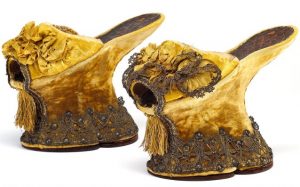

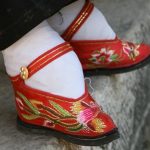 made of something with no give to it, or has no heel on it, the woman wearing the heel really can’t even walk by themselves. And believe me, I would need help too, and I’m used to platforms. It’s just that these aren’t platforms. No, they are stilts!! Platforms have been a tradition for a very long time in Europe, clear back to the 17th century, and then they were out of fashion until the 20th century. Really, it wasn’t until Ferragamo reintroduced them in the 1930s that platforms came back in style. In 2009, an exhibition was organized, with an accompanying catalog on the topic of these elevating shoes, titled “On A Pedestal: From Renaissance Chopines to Baroque Heels.” Chopines, which were also known as zoccoli or pianelle, are a platform shoe up to 20 inches high. Of course, those who wore them required the help of servants so that they didn’t fall flat on their face…in the name of fashion. The idea of chopines, besides being a fashion statement, was to protect the wearer’s clothes from street mud. Never mind the servant’s clothes, and really, why did they have to go out in the
made of something with no give to it, or has no heel on it, the woman wearing the heel really can’t even walk by themselves. And believe me, I would need help too, and I’m used to platforms. It’s just that these aren’t platforms. No, they are stilts!! Platforms have been a tradition for a very long time in Europe, clear back to the 17th century, and then they were out of fashion until the 20th century. Really, it wasn’t until Ferragamo reintroduced them in the 1930s that platforms came back in style. In 2009, an exhibition was organized, with an accompanying catalog on the topic of these elevating shoes, titled “On A Pedestal: From Renaissance Chopines to Baroque Heels.” Chopines, which were also known as zoccoli or pianelle, are a platform shoe up to 20 inches high. Of course, those who wore them required the help of servants so that they didn’t fall flat on their face…in the name of fashion. The idea of chopines, besides being a fashion statement, was to protect the wearer’s clothes from street mud. Never mind the servant’s clothes, and really, why did they have to go out in the 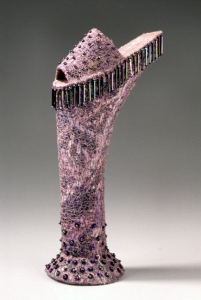
 mud anyway? They were aristocrats, couldn’t someone just carry them on a platform chair, or run their errand for them. Whatever the case may be, I will not be buying a pair of these crazy stilt platforms, should they ever come into style again.
mud anyway? They were aristocrats, couldn’t someone just carry them on a platform chair, or run their errand for them. Whatever the case may be, I will not be buying a pair of these crazy stilt platforms, should they ever come into style again.
I do love my many styles of shoes, and my platforms are among the favorites, but I draw the line at about a 3 inch platform. Much more than that, and I not only have difficulty walking, but I end up taller than everyone around me, and for me that is just too odd. I am used to being one of the “wee ones,” as my niece Kellie Hadlock calls me, and that’s ok with me. I never wanted to be tall anyway. I’ll let my platforms make me look tall. I’m good with that!!
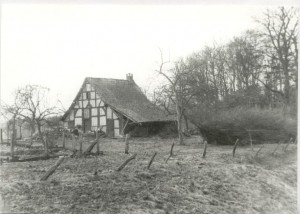 Most of us can trace our roots back to certain people and even certain regions, but not everyone can trace their roots back to a certain house that our ancestor owned in 1628. I can’t say if Johann Schulenberg built the home on the farm, as did my ancestor in the case of, my cousin Princess Diana’s family’s home, Althorpe in England, which has been owned by her family since it was built by Robert Spencer the 2nd Earl of Sunderland in 1688.
Most of us can trace our roots back to certain people and even certain regions, but not everyone can trace their roots back to a certain house that our ancestor owned in 1628. I can’t say if Johann Schulenberg built the home on the farm, as did my ancestor in the case of, my cousin Princess Diana’s family’s home, Althorpe in England, which has been owned by her family since it was built by Robert Spencer the 2nd Earl of Sunderland in 1688.
The Schulenberg family owned a large farm near Schorlingborstel, Bassum, Germany. When I say a large farm, I mean that the land they owned was bigger than many of the surrounding towns at that time in history, and probably many still today. I’m not sure what they have  farmed over the years, but I do know that the farm was large enough to need its own Firehouse. I also know over the centuries, the buildings have been so well kept that they are still in use today, and look fantastic.
farmed over the years, but I do know that the farm was large enough to need its own Firehouse. I also know over the centuries, the buildings have been so well kept that they are still in use today, and look fantastic.
It is very strange to think about the fact that over the years, many of our family’s Schulenberg ancestors have lived in those buildings, and worked in those fields. The farm has a large barn and a garage for the farm equipment, as well as a bakery, which I found strange, but I’m sure it was necessary at that time. My guess would also be that there were a number of servants and hired hands over the centuries, so the bakery was probably very busy keeping the household and all the workers in bread. I have to think that the Schulenberg farm was a very large operation. I would love to have seen it  when it was in full swing back then.
when it was in full swing back then.
I don’t know if the farm is used for farming today or if it is simply a very large estate home, but it is still in beautiful condition, and I really like the traditional German design of the siding on the buildings. I also don’t know if the family that lives there now are related for sure or not, but I can say that they have a home that is filled with so much of the history of days gone by. It seems to me, that all that history would literally emanate the property, but maybe that’s just me.
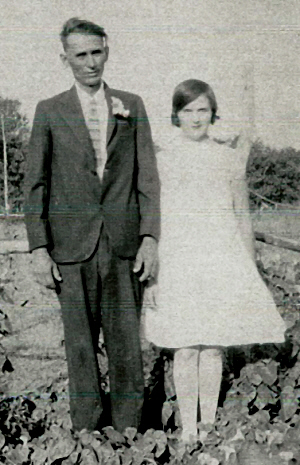 These days, many young women graduate from high school and then go on the college or just out into the work world, but years ago, women who weren’t married by the time they were 20 years old were considered old maids. Some of the women were married as young as 13 years old. These days people would look at that in a very different way…especially since the husbands were often older, often in their mid-twenties or older. Strange as it seems to us today, back then most of these marriages turned into life long loves and lots of children. Of course, as far back as I have looked into, 13 wasn’t a common age for a woman to marry, but the mid to late teens certainly was.
These days, many young women graduate from high school and then go on the college or just out into the work world, but years ago, women who weren’t married by the time they were 20 years old were considered old maids. Some of the women were married as young as 13 years old. These days people would look at that in a very different way…especially since the husbands were often older, often in their mid-twenties or older. Strange as it seems to us today, back then most of these marriages turned into life long loves and lots of children. Of course, as far back as I have looked into, 13 wasn’t a common age for a woman to marry, but the mid to late teens certainly was.
Many of the women in my family were among those who were married at 16 or 17 years of age, and according to my Aunt Sandy, one of our grandmothers was married at 13, but I haven’t been able to find out which one, so I guess I’ll have to ask her. It could be that I’m just not going back far enough. The girls back in 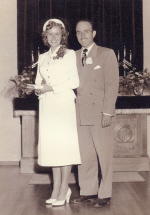 the early days of our nation were raised to be homemakers. The were taught how to run a home and take care of a family. Many is the south were taught to oversee a house full of servants. I can’t imagine running a home, children or a house full of servants at the tender age of 13. I don’t know about you, but at 13, I was definitely not interested in being a wife, mother, and boss. I was too busy doing gymnastics on the front lawn, or hanging out with my friends.
the early days of our nation were raised to be homemakers. The were taught how to run a home and take care of a family. Many is the south were taught to oversee a house full of servants. I can’t imagine running a home, children or a house full of servants at the tender age of 13. I don’t know about you, but at 13, I was definitely not interested in being a wife, mother, and boss. I was too busy doing gymnastics on the front lawn, or hanging out with my friends.
Why were these women to be so different? I mean, they weren’t forced into marriage, they chose it. Yes, they were trained to cook and clean, but so was I. Their parents didn’t push marriage on them, nor did they expect it to happen that young…I don’t believe anyway. I guess that some girls grow up faster than others, or maybe the expectations of the parents carries more weight than we know. I wonder if we will ever really understand the reasons behind those early marriages.

